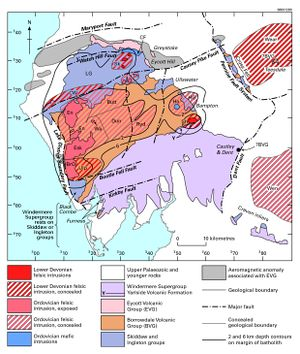Caradoc magmatism, Ordovician, Northern England
From: Stone, P, Millward, D, Young, B, Merritt, J W, Clarke, S M, McCormac, M and Lawrence, D J D. 2010. British regional geology: Northern England. Fifth edition. Keyworth, Nottingham: British Geological Survey.
Introduction


During Caradoc times, the Lake District was the focus for one of the most intense episodes of igneous activity seen during the geological history of the British Isles. A chain of volcanoes lay along the margin of Eastern Avalonia, at least from eastern Ireland, through the Lake District, the English Midlands and into Belgium. In the Lake District, two subaerial volcanic successions were built up within opposing half-grabens, each originally 40 to 50 km wide. Preserved in the northern one is the Eycott Volcanic Group — more than 3200 m of basaltic, andesitic and dacitic lavas and sills with subordinate pyroclastic rocks (P916043). In the southern half-graben, the Borrowdale Volcanic Group comprises at least 6000 m of basaltic to rhyolitic lavas and sills, along with voluminous pyroclastic and volcaniclastic sedimentary rocks. The Borrowdale sequence contains evidence for the former existence of caldera volcanoes and local extensional basins (P005109). It is one of only a handful of volcanic suites worldwide with rocks that contain garnet phenocrysts. In association with the volcanism, components of the Lake District granitic batholith were emplaced beneath the central part of the region at this time (P916043). In the Isle of Man, mafic sheets at Poortown, east of Peel, are intruded into Arenig sedimentary rocks and appear to be geochemically similar to the Lake District’s Caradoc volcanic rocks. Also in the Isle of Man, the biotite-bearing Dhoon Granodiorite Pluton and associated Oatlands Complex may be a product of the Caradoc magmatic phase, but might equally have been emplaced later, at the time of the Acadian Orogeny (see Chapter 5).
The extensional tectonic regime and successive episodes of caldera collapse are seen as the main mechanisms for preservation of the subaerial volcanic rocks in the Lake District. Such occurrences are rare in the geological record and the Borrowdale Volcanic Group is a particularly well exposed example. Most subaerial volcanoes, particularly those constructed with abundant pyroclastic deposits, are more usually disintegrated explosively, weathered, eroded and redeposited in subaqueous sedimentary regimes. The depth of erosion present in the Lake District provides a three-dimensional model of the volcanic system that is rarely available in modern, silicic caldera volcanoes.
The Borrowdale Volcanic Group is also noteworthy in that it provides evidence for the emergence of terrestrial arthropods from a freshwater, rather than marine, environment. In the south-west of the outcrop bedding surfaces in sedimentary rocks exhibit trails and trackways attributed to a myriapod-like organism; this is one of the earliest known records of the existence of terrestrial arthropods. The traces were preserved in shallow-water, lacustrine sediments subjected to episodic drying-out, as demonstrated by the presence of desiccation cracks, and it would seem likely that the organisms survived subaerial conditions, at least temporarily.
Bibliography
Beddoe-Stephens, B, Petterson, M G, Millward, D, and Marriner, G F. 1995. Geochemical variation and magmatic cyclicity within an Ordovician continental-arc volcanic field: the lower Borrowdale Volcanic Group, English Lake District. Journal of Volcanology and Geothermal Research, Vol. 65, 81–110.
Branney, M J, and Kokelaar, B P. 1994. Volcanotectonic faulting, soft-state deformation and rheomorphism of tuffs during development of a piecemeal caldera, English Lake District. Geological Society of America Bulletin, Vol. 106, 507–530.
Branney, M J, and Soper, N J. 1988. Ordovician volcano-tectonics in the English Lake District. Journal of the Geological Society of London, Vol. 145, 367–376.
Branney, M J, and Suthren, R J. 1988. High-level peperitic sills in the English Lake District: distinction from block lavas and implications for Borrowdale Volcanic Group stratigraphy. Geological Journal, Vol. 23, 171–187.
Fitton, J G. 1972. The genetic significance of almandine-pyrope phenocrysts in the calcalkaline Borrowdale Volcanic Group, northern England. Contributions to Mineralogy and Petrology, Vol. 36, 231–248.
Hughes, R A, Evans, J A, Noble, S R, and Rundle, C C. 1996. U-Pb chronology of the Ennerdale and Eskdale intrusions supports subvolcanic relationships with the Borrowdale Volcanic Group (Ordovician, English Lake District). Journal of the Geological Society of London, Vol. 153, 33–38.
Johnson, E W, Briggs, D E G, Suthren, R J, Wright, J L, and Tunnicliff, S P. 1994. Non-marine arthropod traces from the subaerial Ordovician Borrowdale Volcanic Group, English Lake District. Geological Magazine, Vol. 131, 395–406.
Millward, D. 2002. Early Palaeozoic magmatism in the English Lake District. Proceedings of the Yorkshire Geological Society, Vol. 54, 65–93.
Millward, D. 2004. The Caradoc volcanoes of the English Lake District. Proceedings of the Yorkshire Geological Society, Vol. 55, 73–105.
Millward, D, and Evans, J A. 2003. U-Pb chronology and duration of upper Ordovician magmatism in the English Lake District. Journal of the Geological Society of London, Vol. 160, 773–781.
Millward, D, Beddoe-Stephens, B, Williamson, I T, Young, S R, and Petterson, M G. 1994. Lithostratigraphy of a concealed caldera-related ignimbrite sequence within the Borrowdale Volcanic Group of west Cumbria. Proceedings of the Yorkshire Geological Society, Vol. 50, 25–36.
Millward, D, Marriner, G F, and Beddoe-Stephens, B. 2000. The Eycott Volcanic Group, an Ordovician continental-margin andesitic suite in the English Lake District. Proceedings of the Yorkshire Geological Society, Vol. 53, 81–96.
Petterson, M G, Beddoe-Stephens, B, Millward, D, and Johnson, E W. 1992. A pre-caldera plateau-andesite field in the Borrowdale Volcanic Group of the English Lake District. Journal of the Geological Society of London, Vol. 149, 889–906.
Piper, J D A, Stephen, J C, and Branney, M J. 1997. Palaeomagnetism of the Borrowdale and Eycott volcanic groups, English Lake District: primary and secondary magnetisation during a single late Ordovician polarity chron. Geological Magazine, Vol. 134, 481–506.